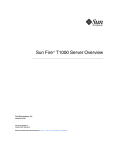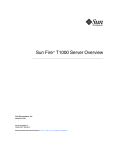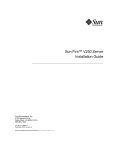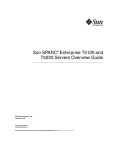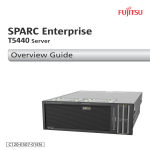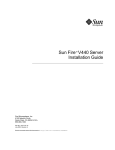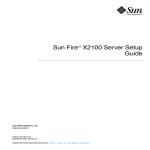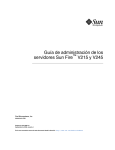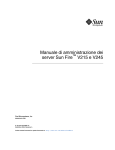Download Sun Fire V215 and V245 Servers Getting Started Guide
Transcript
Sun Fire™ V215 and V245 Servers Getting Started Guide Sun Microsystems, Inc. www.sun.com Part No. 819-3041-10 September 2006, Revision 04 Submit comments about this document at: http://www.sun.com/hwdocs/feedback Copyright 2006 Sun Microsystems, Inc., 4150 Network Circle, Santa Clara, California 95054, U.S.A. All rights reserved. Sun Microsystems, Inc. has intellectual property rights relating to technology that is described in this document. In particular, and without limitation, these intellectual property rights may include one or more of the U.S. patents listed at http://www.sun.com/patents and one or more additional patents or pending patent applications in the U.S. and in other countries. This document and the product to which it pertains are distributed under licenses restricting their use, copying, distribution, and decompilation. No part of the product or of this document may be reproduced in any form by any means without prior written authorization of Sun and its licensors, if any. Third-party software, including font technology, is copyrighted and licensed from Sun suppliers. Parts of the product may be derived from Berkeley BSD systems, licensed from the University of California. UNIX is a registered trademark in the U.S. and in other countries, exclusively licensed through X/Open Company, Ltd. Sun, Sun Microsystems, the Sun logo, Sun Fire, Java, J2EE, OpenBoot, and Solaris are trademarks or registered trademarks of Sun Microsystems, Inc. in the U.S. and in other countries. All SPARC trademarks are used under license and are trademarks or registered trademarks of SPARC International, Inc. in the U.S. and in other countries. Products bearing SPARC trademarks are based upon an architecture developed by Sun Microsystems, Inc. The OPEN LOOK and Sun™ Graphical User Interface was developed by Sun Microsystems, Inc. for its users and licensees. Sun acknowledges the pioneering efforts of Xerox in researching and developing the concept of visual or graphical user interfaces for the computer industry. Sun holds a non-exclusive license from Xerox to the Xerox Graphical User Interface, which license also covers Sun’s licensees who implement OPEN LOOK GUIs and otherwise comply with Sun’s written license agreements. U.S. Government Rights—Commercial use. Government users are subject to the Sun Microsystems, Inc. standard license agreement and applicable provisions of the FAR and its supplements. DOCUMENTATION IS PROVIDED "AS IS" AND ALL EXPRESS OR IMPLIED CONDITIONS, REPRESENTATIONS AND WARRANTIES, INCLUDING ANY IMPLIED WARRANTY OF MERCHANTABILITY, FITNESS FOR A PARTICULAR PURPOSE OR NON-INFRINGEMENT, ARE DISCLAIMED, EXCEPT TO THE EXTENT THAT SUCH DISCLAIMERS ARE HELD TO BE LEGALLY INVALID. Copyright 2006 Sun Microsystems, Inc., 4150 Network Circle, Santa Clara, Californie 95054, Etats-Unis. Tous droits réservés. Sun Microsystems, Inc. a les droits de propriété intellectuels relatants à la technologie qui est décrit dans ce document. En particulier, et sans la limitation, ces droits de propriété intellectuels peuvent inclure un ou plus des brevets américains énumérés à http://www.sun.com/patents et un ou les brevets plus supplémentaires ou les applications de brevet en attente dans les Etats-Unis et dans les autres pays. Ce produit ou document est protégé par un copyright et distribué avec des licences qui en restreignent l’utilisation, la copie, la distribution, et la décompilation. Aucune partie de ce produit ou document ne peut être reproduite sous aucune forme, par quelque moyen que ce soit, sans l’autorisation préalable et écrite de Sun et de ses bailleurs de licence, s’il y en a. Le logiciel détenu par des tiers, et qui comprend la technologie relative aux polices de caractères, est protégé par un copyright et licencié par des fournisseurs de Sun. Des parties de ce produit pourront être dérivées des systèmes Berkeley BSD licenciés par l’Université de Californie. UNIX est une marque déposée aux Etats-Unis et dans d’autres pays et licenciée exclusivement par X/Open Company, Ltd. Sun, Sun Microsystems, le logo Sun, Sun Fire, Java, J2EE, OpenBoot, et Solaris sont des marques de fabrique ou des marques déposées de Sun Microsystems, Inc. aux Etats-Unis et dans d’autres pays. Toutes les marques SPARC sont utilisées sous licence et sont des marques de fabrique ou des marques déposées de SPARC International, Inc. aux Etats-Unis et dans d’autres pays. Les produits portant les marques SPARC sont basés sur une architecture développée par Sun Microsystems, Inc. L’interface d’utilisation graphique OPEN LOOK et Sun™ a été développée par Sun Microsystems, Inc. pour ses utilisateurs et licenciés. Sun reconnaît les efforts de pionniers de Xerox pour la recherche et le développement du concept des interfaces d’utilisation visuelle ou graphique pour l’industrie de l’informatique. Sun détient une license non exclusive de Xerox sur l’interface d’utilisation graphique Xerox, cette licence couvrant également les licenciées de Sun qui mettent en place l’interface d ’utilisation graphique OPEN LOOK et qui en outre se conforment aux licences écrites de Sun. LA DOCUMENTATION EST FOURNIE "EN L’ÉTAT" ET TOUTES AUTRES CONDITIONS, DECLARATIONS ET GARANTIES EXPRESSES OU TACITES SONT FORMELLEMENT EXCLUES, DANS LA MESURE AUTORISEE PAR LA LOI APPLICABLE, Y COMPRIS NOTAMMENT TOUTE GARANTIE IMPLICITE RELATIVE A LA QUALITE MARCHANDE, A L’APTITUDE A UNE UTILISATION PARTICULIERE OU A L’ABSENCE DE CONTREFAÇON. Please Recycle Contents Servers Overview 1 Server Installation Process Site Preparation 3 4 Physical Specifications 5 Environmental Requirements 5 Operating Environment 6 Airflow Considerations 7 Acoustic Noise 7 Operating Power Limits and Ranges 7 Calculating Power Consumption 8 Calculating Heat Dissipation Shipping Kit Contents Front Panel 8 9 DVD Dual Drive Hard Drives 10 10 Power and Locator Buttons Status Indicators Front USB Ports Rear Panels 8 11 11 12 12 iii Power Inlets 13 Network Connectors Ethernet Ports Serial Ports 15 15 USB 2.0 Ports PCI Expansion Cabling Notes 14 16 16 17 Minimum Connections 17 System Controller Management Ports Socketed System Configuration Chip Preinstalled Software 17 17 18 Solaris Operating System 18 Java Enterprise System Software OpenBoot PROM Diagnostics 19 20 Sun Advanced Lights Out Manager 20 System Reliability, Availability, and Serviceability Hot-Swappable Components 21 Power Supply Redundancy 22 Environmental Monitoring 22 Sun Fire V215 and V245 Documentation Documentation, Support, and Training Third-Party Web Sites 24 24 Sun Welcomes Your Comments iv 23 24 Sun Fire V215 and V245 Servers Getting Started Guide • September 2006 21 Introducing the Sun Fire V215 and V245 Servers This guide provides you with a starting point for getting started with the Sun Fire™ V215 and V245 servers. This guide also includes links to the resources available for these servers, instructions for planning the installation of a Sun Fire V215 or V245 server, and information for locating the cable connections, configuring the server and preinstalled software, and finding more information about these servers. Servers Overview The Sun Fire V215 and V245 servers represent follow on products of the Sun Fire V210 and V240 servers and introduce several new features: ■ ■ ■ ■ ■ ■ ■ UltraSPARC® IIIi CPUs PCI-Express I/O boards SAS hard drives Hot-swap fans Hot-swap power supplies Dynamic FRU ID ALOM Secure Shell and SNMP support The Sun Fire V215 and V245 servers can be mounted in a standard 19 inch rack, and they ship with the Solaris™ 10 Operating System (OS), the Java™ Enterprise System, and the Advanced Lights Out Manager (ALOM) software preinstalled as a software image on the boot drive. These servers have the following platform names: ■ ■ SUNW,Sun-Fire-V215 SUNW,Sun-Fire-V245 1 Both servers have the following common features: ■ ■ ■ ■ ■ ■ ■ ■ ■ One or two CPUs One megabyte of L2 cache Eight DDR-1 DIMM slots Four 10/100/1000 megabit Ethernet ports Two USB 2.0 connectors on the rear panel One DVD dual drive (optional) One or two redundant power supplies One ALOM management controller with a serial and 10/100 megabit Ethernet port Solaris 10 6/06, plus mandatory patches, as the minimum level operating system The servers have the following differentiating features: TABLE 1 Server Differentiating Features Sun Fire V215 Sun Fire V245 Height 1 rack unit 2 rack units PCI-X expansion 1 1 PCI-E expansion 2 2 Front USB connectors 1 2 Hard drive bays 2 4 For a detailed list of features, available configurations, and compatible options, go to: http://www.sun.com/servers/ For detailed information about these servers, go to: http://sunsolve.sun.com/ See: Sun System Handbook 2 Sun Fire V215 and V245 Servers Getting Started Guide • September 2006 Server Installation Process This section contains a list of tasks that you must complete during the installation process. Each task includes a reference to the appropriate instructions. Each task must be completed in order. 1. Preparing the site according to the power, clearance, and environmental requirements. If you are installing the server into a new Sun™ rack, you must fully prepare the site for the installation. If you are installing the server into an existing rack, you must conduct some site preparation to satisfy the additional power and environmental requirements. See “Site Preparation” on page 4 for specific instructions. 2. Downloading the appropriate documentation. You will need to download the Sun Fire V215 and V245 Servers Installation Guide and the Sun Fire V215 and V245 Servers Product Notes before you attempt to install the server. You can obtain these documents and other guides associated with these servers at: http://www.sun.com/documentation 3. Verifying that you have received all of the components. The Sun Fire server ships in several packages. See “Shipping Kit Contents” on page 8 for a list of the shipping kit. 4. Installing the server into the rack. The installation of the rack slides and cable management arm (CMA) represent the majority of physical work during the installation. 5. Setting up a console to communicate with the server. To set up the console, refer to the Sun Fire V215 and V245 Servers Installation Guide for instructions. Introducing the Sun Fire V215 and V245 Servers 3 6. Obtaining the latest configuration instructions for your server. After you power the server on, you will automatically be taken through the Solaris OS configuration procedure. Therefore, before you power on the server, go to the following site to obtain the latest configuration details: http://www.sun.com/software/preinstall/index.xml 7. Powering on the server and configuring the preinstalled software. The Solaris OS and the Java Enterprise System software are preinstalled on the server. To power on the server and configure the preinstalled software, refer to the Sun Fire V215 and V245 Servers Installation Guide for instructions. 8. Obtaining the latest updates and patches. Use the appropriate links on the preinstalled software site to obtain the latest updates and patches. 9. Setting the desired OpenBoot™ PROM configuration options. The initial boot will test the entire system. You can change the level of testing by using the OpenBoot PROM commands and configuration variables. To change the boot test level and other boot variables, refer to the OpenBoot PROM Enhancements Diagnostics Operation. 10. (Optional) Loading additional software from the Solaris OS media kit. The Solaris OS media kit is sold separately. The kit includes several CDs containing software to help you operate, configure, and administer your server. Refer to the documentation provided in the media kit for a complete listing of included software and detailed instructions. Site Preparation Before you install the Sun Fire server, you must prepare the site. This section includes information and links to information you need to prepare the site. 4 Sun Fire V215 and V245 Servers Getting Started Guide • September 2006 Physical Specifications TABLE 2 shows the physical specifications for the Sun Fire V215 and V245 servers. TABLE 2 Physical Specifications Sun Fire V215 server Sun Fire V245 server Dimension Value Height 42.7 mm Width 440.3 mm Depth 635.0 mm Weight 15 kg Height 87.36 mm Width 440.3 mm Depth 635.0 mm Weight 18 kg Environmental Requirements You can operate and store the system safely in the conditions detailed in TABLE 3. TABLE 3 Operating and Storage Specifications Specification Operating Storage Ambient temperature -10˚ C to 35˚ C maximum ambient temperature is derated by 1˚ C (V245) and 2˚ C (V215) per 500 m altitude above 500 m -40˚ C to 65˚ C Relative humidity 5% to 80% RH noncondensing, 27˚ C maximum wet bulb 5% to 95% RH noncondensing, 27˚ C maximum wet bulb Altitude 0 m up to 3000 m (at 35˚ C ambient) 0 m up to 12000 m Introducing the Sun Fire V215 and V245 Servers 5 Operating Environment Your environmental control system must provide intake air for the server that complies with the limits specified in “Environmental Requirements” on page 5. To avoid overheating, do not direct warmed air: ■ ■ Toward the front of the cabinet or rack. Toward the server access panels. Note – When you receive your system, leave it in the environment in which you will install it for 24 hours. This helps prevent thermal shock and condensation. The operating environmental limits in TABLE 3 reflect the limits to which the servers have been tested to meet all functional requirements. Operating computer equipment in extremes of temperature or humidity increases the failure rate of hardware components. To minimize the chance of component failure, use the server within the optimal temperature and humidity ranges. Ambient Temperature An ambient temperature range of 21˚ C to 23˚ C is optimal for server reliability. At 22˚ C it is easy to maintain safe relative humidity levels. Operating in this temperature range provides a buffer in the event of the environmental support systems failing. Ambient Relative Humidity Ambient relative humidity levels between 45% and 50% are the most suitable for data processing operations to: ■ ■ ■ Prevent corrosion. Provide an operating time buffer in the event of environmental control system failure. Help avoid failures caused by the intermittent interference from static discharges that occur when relative humidity is too low. Electrostatic discharge (ESD) is easily generated and less easily dissipated in areas where the relative humidity is below 35%, and it becomes critical when levels drop below 30%. 6 Sun Fire V215 and V245 Servers Getting Started Guide • September 2006 Airflow Considerations The Sun Fire V215 and V245 servers self-cool when operated in still air. ■ Ensure unobstructed airflow through the chassis. ■ ■ Sun Fire V215 servers use internal fans that can achieve a total airflow of 30 cfm in normal operating conditions. Sun Fire V245 servers use internal fans that can achieve a total airflow of 60 cfm in normal operating conditions. ■ Ensure that inlet air enters at the front of the server and exits from the back. ■ Ventilation openings for both the inlet and exhaust of the system should provide: ■ ■ ■ Sun Fire V215 server – a minimum open area of 85 cm2 (13 in2) each Sun Fire V245 server – a minimum open area of 170 cm2 (26 in2) each Allow a minimum of 88.9 mm (3.5 inches) clearance at the front and rear of the server when mounted, unless an unobstructed airflow can be ensured. Acoustic Noise TABLE 4 shows the amount of acoustic noise generated by the Sun Fire V215 and V245 servers. TABLE 4 Acoustic Noise Server Noise Generated Sun Fire V215 server Less than 80 dBA sound power in ambient temperature of up to 24˚ C, measured on a standalone system to ISO 9296 requirements Sun Fire V245 server Less than 80 dBA sound power in ambient temperature of up to 24˚ C, measured on a standalone system to ISO 9296 requirements Operating Power Limits and Ranges TABLE 5 shows the operating power for the Sun Fire V215 and V245 servers. TABLE 5 Operating Power Limits and Ranges Description Sun Fire V215 Server Sun Fire V245 Server Operating input voltage range 90 - 264 volts 90 - 264 volts Introducing the Sun Fire V215 and V245 Servers 7 TABLE 5 Operating Power Limits and Ranges Description Sun Fire V215 Server Sun Fire V245 Server Operating frequency range 47 - 63 Hz 47 - 63 Hz Maximum operating current 8 Amps @ 90 VAC 8 Amps @ 90 VAC Maximum AC input 670 watts 670 watts Calculating Power Consumption The estimated power consumed in a fully powered server depends on the configuration of the server. For more information on calculating power consumption, contact your Sun sales representative. Calculating Heat Dissipation To calculate the heat generated by a server so that you can estimate the heat your cooling system must dissipate, convert the figure for the server’s power requirement from Watts to BTU/hr. A general formula for doing this is to multiply the power requirement figure in Watts by 3.412. Shipping Kit Contents The server is supplied with the components described in the following list: ■ ■ ■ Rackmount kit Cat5 RJ-45 cable Accessories kit: ■ RJ-45 adaptor ■ Sun Fire V215 and V245 Getting Started Guide (819-3041) ■ Important Safety Information for Sun Servers (816-7190) ■ Sun Server Documentation (819-4953) ■ Entitlement for Solaris 10 6/06 (819-5836) ■ Software License Agreement (819-0764) Note – The contents of the shipping kit might vary, depending on any options that you have ordered. Ensure that all the basic parts, as described in the list, are present in the shipping kit. If any component is missing, contact your Sun sales representative. 8 Sun Fire V215 and V245 Servers Getting Started Guide • September 2006 Front Panel This section contains views of the front panels of the servers. These views will help you become familiar with the features on the front panels so that you can install the servers, set up the cabling, or operate the servers. On each server, the front panel contains the DVD dual drive, hard drives, status indicators, and USB port(s). FIGURE 1 shows the front panel on the Sun Fire V215 server, and FIGURE 2 shows the front panel on the Sun Fire V245 server. Indicators and buttons DVD dual drive (optional) Hard drive 0 USB Port 2 FIGURE 1 Hard drive 1 Hard drive indicators Front Panel on the Sun Fire V215 Server Indicators and buttons USB ports DVD dual drive (optional) Drive 2 Drive 3 Drive 0 Drive 1 Hard drives Hard drive indicators 3 2 FIGURE 2 Front Panel on the Sun Fire V245 Server Introducing the Sun Fire V215 and V245 Servers 9 DVD Dual Drive Both servers support an optional, slim-line IDE DVD dual drive. The drive connects to the motherboard by a custom flex cable. The DVD dual drive is powered by 5 volts and supports the following formats: TABLE 6 Supported Formats for the DVD Dual Drive Media Types Read Write CD-ROM X CD-R X X CD-RW X X DVD-ROM X DVD-R X X DVD+R X X DVD-RW X X DVD+RW X X Note – The DVD dual drive does not support dual-layer DVD disks. Hard Drives The Sun Fire V215 server supports two 2.5 inch serial attached SCSI (SAS) hard drives, and the Sun Fire V245 server supports four 2.5 inch SAS hard drives. The drives are hot-pluggable. The preparation procedures vary depending on how the drive is used in the configuration. File systems must be unmounted and raw partitions must no longer be in use before these hard drives are removed. Each hard drive has three status indicators associated with it. See TABLE 7 for a summary of what the indicators mean. TABLE 7 Indicator LED color LED State Component Status Removal Blue On Ready to remove Off Not ready to remove On Being used Usage 10 Hard Drive Indicators Amber Sun Fire V215 and V245 Servers Getting Started Guide • September 2006 TABLE 7 Hard Drive Indicators Indicator Activity LED color Green LED State Component Status Off Not used Flashing Active SCSI transactions Off No activity Power and Locator Buttons Both servers have Power buttons on the front panel and rear panels, and they have a Locator button on the front panel and a Locator LED on the rear panel. The following list provides descriptions on how these buttons and LEDs operate: ■ When the main power is off, depressing the Power button once signals the power supply units to turn on the main output (+12 volts). ■ When the main power is on and the Solaris OS is running, depressing the Power button once initiates a graceful shutdown of the Solaris OS. The system management processor continues to run because it operates on the 3.3 volt standby power circuit. ■ When the main power is on and the Solaris OS is running, depressing and holding down the Power button for four seconds initiates an immediate shutdown of the server by signaling the power supply units to turn off the main +12 volt outputs. ■ Depressing the Locator button turns on a flashing white LED. ■ Depressing the Locator button again turns off the Locator LED. Caution – When power cord is connected, standby power is still present at the service processor. Status Indicators Both servers have indicators on the front panel. The following list contains descriptions of the indicators: ■ ■ Service Required* (amber) – indicates that service is required Power OK indicator/button* (green) – indicates the state of the server: ■ ■ ■ ■ Off – not running in its normal state On – powered on and running Fast blink – running in standby mode Slow blink – running in a transitory state Introducing the Sun Fire V215 and V245 Servers 11 ■ ■ ■ Fan Fault (amber) – when on, indicates a fan failure event occurred PSU Fault (amber) – when on, indicates that a power supply failure event occurred Overtemperature (amber) – when on, indicates that a temperature failure event occurred * Indicator is provided on the front and rear of the chassis. Front USB Ports The Sun Fire V215 server has one USB port (Port 2) on the front panel. The Sun Fire V245 server has two USB ports (Ports 2 and 3) located on the front panel. The USB ports on the front panel on the Sun Fire V245 server cannot be used for keyboard or mouse input devices. With cable lengths of more than 2 meters or for a UDES USB device, these ports will only support USB 1.1. With cable lengths shorter than 2 meters, these ports will support USB 2.0. Rear Panels Before you attach and route the cables, become familiar with the location of the power inlets and I/O ports on the back of the servers. FIGURE 3 shows the rear panel for the Sun Fire V215 server, and FIGURE 4 shows the rear panel for the Sun Fire V245 server. Power inlets PCI-X slot 1 PCI-E slot 0 Ethernet indicators Network indicator 3 2 1 0 PSU indicators NET MGT SER TTYB SER MGT FIGURE 3 12 USB Sun Fire V215 Server Rear Panel Sun Fire V215 and V245 Servers Getting Started Guide • September 2006 Ethernet connectors System indicators PCI-E slot 2 Power inlets PCI-X slot 3 PCI-X slot 1 PCI-E slot 0 3 2 1 0 PSU indicators FIGURE 4 Network indicator NET MGT SER TTYB SER MGT Ethernet System indicators indicators USB Ethernet connectors Sun Fire V245 Server Rear Panel Power Inlets The Sun Fire V215 and V245 servers can have one or two power inlets, one for each power supply unit (PSU). As long as the server is connected to a power source, the server is in Standby power mode. The only way to turn the server fully off is to remove the server from the power source by unplugging the power cable. Do not attach power cables to the power supplies until you have finished connecting the data cables and have connected the server to a serial terminal or a terminal emulator. When the power cables are connected, the server goes into Standby mode, and the SC boots. System messages can be lost if the server is not connected to a terminal at this time. The Sun Fire V245 and V215 servers can have dual redundant PSUs. Each PSU has three status indicators that tell you if the PSU is active, if the PSU has an internal error, or if the PSU is ready to be removed. TABLE 8 includes summaries of the function of the indicators. TABLE 8 Power Supply Unit Indicators OK (green) Fault (amber) AC (green) PSU Condition Off Off On Power is present, and PSU is in standby mode. Introducing the Sun Fire V215 and V245 Servers 13 TABLE 8 Power Supply Unit Indicators (Continued) OK (green) Fault (amber) AC (green) PSU Condition On Off On Power is present, and PSU is active. Off On On Power is present; however, the PSU has an internal fault and requires service. Off On or Off Off PSU has shut down due to internal fault or loss of power. Network Connectors Each network connector has two status indicators. The network status indicators convey: ■ ■ Network link status Network speed status (does not apply to the NET MGT port) TABLE 9 includes summaries of what the Network Link Status indicators mean. TABLE 9 Network Link Indicators LED color LED State Network Link Status Green On Link is established. Blinking Link is transferring data. Off Link is not established. TABLE 10 includes summaries of what the network speed indicators mean. TABLE 10 14 Network Speed Indicator LED color LED State Network Speed Status Green On The network link is established and running at its maximum supported speed. Off • If the network activity indicator is off, the network link is established but not running at its maximum supported speed. • If the network activity indicator is off, network link is not established. Sun Fire V215 and V245 Servers Getting Started Guide • September 2006 Ethernet Ports The Sun Fire V215 and V245 servers each have four autonegotiating 10/100/1000BASE-T Ethernet system domain ports. All of the Ethernet ports use a standard RJ-45 connector, the transfer rates for which are given in TABLE 11. TABLE 11 Ethernet Connection Transfer Rates Connection Type IEEE Terminology Transfer Rate Ethernet 10BASE-T 10 Mbit/s Fast Ethernet 100BASE-TX 100 Mbits/s Gigabit Ethernet 1000BASE-T 1000 Mbit/s In addition, each server has one 10BASE-T Ethernet management domain interface, labeled NET MGT. For information on configuring this port for managing the server with ALOM, see the Sun Advanced Lights Out Management (ALOM) Administration Guide. Serial Ports The server has two serial ports, labelled SER MGT and SER TTYB. The SER MGT port accepts an RJ-45 connector. Use this port only for server management. The port labeled SER TTYB accepts an RJ-45 connector. Use this port for general purpose, asynchronous serial data transfer. For serial devices, use the SER TTYB port and an RJ-45 adaptor with a null modem cable. This port appears as ttyb in Solaris OS and OpenBoot PROM messages and is not connected to the SC serial management port. The default serial connection settings are listed in TABLE 12. TABLE 12 Default Serial Connection Settings Parameter Setting Connector SER MGT or SER TTYB Rate 9600 baud Introducing the Sun Fire V215 and V245 Servers 15 TABLE 12 Default Serial Connection Settings Parameter Setting Parity None Stop bits 1 Data bits 8 If you need to connect to the SER MGT port using either a DB-9 or a DB-25 connector, use an adapter to perform the cross-overs. See the Sun System Handbook for more information about the cross-overs. USB 2.0 Ports Both servers have two USB 2.0 ports (0 and 1) on the rear panel. Use ports 0 and 1 to connect input devices such as a keyboard and mouse. The USB ports support hotplugging. You can connect and disconnect USB cables and peripheral devices while the system is running without affecting system operations. You can perform USB hot-plug operations only while the Solaris OS is running. You must run the devfsadm -C command after a USB hot-plug operation. USB hot-plug operations are not supported when the OpenBoot PROM prompt is displayed or before the system has completed booting. PCI Expansion Both servers use a variety of riser cards to provide different combinations of PCI-E and PCI-X expansion slots. For a detailed list of expansion options, go to: http://www.sun.com/servers/ 16 Sun Fire V215 and V245 Servers Getting Started Guide • September 2006 Cabling Notes This section contains important notes about cabling the server. Minimum Connections The following list includes the minimum cable connections for the Sun Fire V215 and V245 servers: ■ ■ ■ ■ At least one Ethernet network connection (NET port) SC serial management port (SER MGT port) SC network management port (NET MGT port) Power cable(s) System Controller Management Ports There are two SC management ports for use with the ALOM system controller: ■ SC serial management port (labeled SER MGT) which uses an RJ-45 cable This port is the default connection to the SC and is always available. ■ SC network management port (labeled NET MGT) which uses an RJ-45 cable This port is the optional connection to the SC. It is not available until you configure the network settings for the SC through the serial management port. This port does not support connections to Gigabit networks. However, it will correctly negotiate to a lower speed if connected to a 10/100/1000 Gigabit Ethernet switch. Socketed System Configuration Chip Both servers include a socketed system configuration chip (SSCC). This device is located on the motherboard and enables the user to transport vital system information from one machine to another in the event of a unrecoverable system failure. Introducing the Sun Fire V215 and V245 Servers 17 From an architectural perspective, the SSCC performs a function similar to the NVRAM or SEEPROM devices used in previous Sun products. The SSCC contains the following data structures used by the Sun Fire V215 and V245 service processor: ■ ■ ■ Host ID Ethernet MAC addresses for all host Ethernet interfaces Ethernet MAC addresses for ALOM Ethernet interface Preinstalled Software The Sun Fire V215 and V245 servers are shipped with the Solaris 10 Operating System (OS) and the Java Enterprise System software. You must configure the preinstalled software as part of the installation process. However, before you begin the configuration process, go to: http://www.sun.com/software/preinstall/ This site contains the latest information about the preinstalled software and links to the software updates and patches you must install. Solaris Operating System The Solaris 10 OS is preinstalled on both servers and offers the following features: 18 ■ Stability, high performance, scalability, and precision of a mature 64-bit operating system. ■ Support for over 12,000 leading technical and business applications. ■ Solaris Containers – Isolates software applications and services using flexible, software-defined boundaries. ■ DTrace – Provides comprehensive dynamic tracing framework for tuning applications and troubleshooting systemic problems in real time. ■ ZFS – Provides a simple administration model. ■ Security – Provides advanced security features designed to protect the enterprise at multiple levels. ■ Network performance – Completely rewritten TCP/IP stack dramatically improves the performance and scalability of your networked services. Sun Fire V215 and V245 Servers Getting Started Guide • September 2006 Java Enterprise System Software The Java Enterprise System software includes a free 90-day evaluation license for the following Java Enterprise System software applications: ■ Access Manager – A security foundation that helps manage secure access to an enterprises’ web applications by offering single sign-on (SSO) as well as enabling federation across trusted networks. ■ Application Server – Provides a Java 2 Platform, Enterprise Edition (J2EE™ platform) 1.4 compatible platform for developing and delivering server-side Java applications and web services. ■ Calendar Server – A web-based tool that facilitates team collaboration by enabling users to manage and coordinate appointments, events, tasks, and resources. ■ Cluster software – Delivers high availability to enterprise system applications. ■ Directory Server – User-management infrastructure for enterprises that manage high volumes of user information. The Directory Server provides a centralized repository for storing and managing user profiles and access privileges, as well as application and network resource information. ■ Directory Proxy Server – Provides secure firewall-like services for the Directory Server. ■ Instant Messaging – A standards-based, real-time communication and collaboration application. ■ Message Queue – An enterprise-level message server using a standards-based (JMS) messaging solution. ■ Messaging Server – A high-performance, highly secure messaging platform that provides security features that help ensure the integrity of communications. ■ Portal Server – Provides portal services that identify users through centralized identity services using roles and policies. ■ Web Server – A secure, reliable, easy-to-use web server designed for medium and large business applications. To gain the benefits of the Java Enterprise System, you can buy a subscription license for a Java Enterprise System Suite or a combination of Java System Suites. Introducing the Sun Fire V215 and V245 Servers 19 OpenBoot PROM Diagnostics With the upgrade to OpenBoot PROM 4.18.5 or a subsequently compatible version of the OpenBoot PROM, diagnostics are enabled by default. This ensures complete diagnostic test coverage on the initial boot and after error reset events. This change results in increased boot time. To change the system defaults and diagnostic settings after the initial boot, refer to OpenBoot PROM Enhancements for Diagnostic Operation (817-6957). To obtain this document, go to: http://www.sun.com/products-n-solutions/hardware/docs/ Sun Advanced Lights Out Manager The Sun Fire V215 and V245 servers ship with the Sun Advanced Lights Out Manager (ALOM) software installed. The system console is directed to ALOM by default and is configured to show server console information on startup. ALOM enables you to monitor and control your server over either a serial connection (using the SER MGT port) or Ethernet connection (using the NET MGT port). For information about configuring an Ethernet connection, refer to the Sun Advanced Lights Outs Manager User’s Guide. Note – The ALOM serial port, labeled SER MGT, is for server management only. If you need a general-purpose serial port, use the serial port labeled SER TTYB. You can configure ALOM to send email alerts of hardware failures, hardware warnings, and other events related to the server or to ALOM. ALOM monitors the following server components: ■ ■ ■ ■ ■ ■ 20 CPU temperature conditions Hard drive status Enclosure thermal conditions Fan speed and status Power supply status Voltage conditions Sun Fire V215 and V245 Servers Getting Started Guide • September 2006 The ALOM circuitry uses standby power from the server. This means that: ■ ■ ALOM is active as soon as the server is connected to a power source, and remains active until power is removed by unplugging the power cable. ALOM continues to be effective even when the operating system is offline and when the server is in Standby mode. For more information about ALOM, see the Sun Advanced Lights Out Management (ALOM) Administration Guide. System Reliability, Availability, and Serviceability Reliability, availability, and serviceability (RAS) are aspects of a system’s design that affect its ability to operate continuously and to minimize the time necessary to service the system. Reliability refers to a system’s ability to operate continuously without failures and to maintain data integrity. System availability refers to the ability of a system to recover to an operational state after a failure, with minimal impact. Serviceability relates to the time it takes to restore a system to service following a system failure. Together, reliability, availability, and serviceability features provide for near continuous system operation. To deliver high levels of reliability, availability, and serviceability, the Sun Fire server offers the following features: ■ ■ ■ ■ ■ ■ Hot-pluggable hard drives Redundant, hot-swappable power supplies Redundant, hot-swappable fans Environmental monitoring Error detection and correction for improved data integrity Easy access for most component replacements Hot-Swappable Components Sun Fire hardware is designed to support hot-swapping of components. You can install or remove these components while the system is running. Hot-swap technology significantly increases the system’s serviceability and availability by providing the ability to replace components without service disruption. Introducing the Sun Fire V215 and V245 Servers 21 Power Supply Redundancy Depending on the configuration, the Sun Fire V215 and V245 servers feature two hot-swappable power supplies, enabling the system to continue operating should one of the power supplies fail or if one power source fails. Environmental Monitoring The Sun Fire servers feature an environmental monitoring subsystem that protects the server and its components against: ■ ■ ■ ■ Extreme temperatures Lack of adequate airflow through the system Power supply failures Hardware faults Temperature sensors are located throughout the system to monitor the ambient temperature of the system and internal components. The software and hardware ensure that the temperatures within the enclosure do not exceed predetermined safe operation ranges. If the temperature observed by a sensor falls below a lowtemperature threshold or rises above a high-temperature threshold, the monitoring subsystem software lights the amber Service Required indicators on the front and back panel. If the temperature condition persists and reaches a critical threshold, the system initiates a graceful system shutdown. In the event of a failure of the service processor, backup sensors protect the system from serious damage, by initiating a forced hardware shutdown. All error and warning messages are sent to the service processor system console and logged in the ALOM console log file. Service Required indicators remain lit after an automatic system shutdown to aid in problem diagnosis. The power subsystem is monitored in a similar fashion by monitoring power supplies and reporting any fault in the front and rear panel indicators. If a power supply problem is detected, an error message is sent to the service processor system console and logged in the ALOM console log file. Additionally, status indicators located on each power supply light to indicate failures. The system Service Required indicator lights to indicate a system fault. 22 Sun Fire V215 and V245 Servers Getting Started Guide • September 2006 Sun Fire V215 and V245 Documentation The documentation that supports these servers is comprised of three categories: ■ Documentation that is specific to the Sun Fire V215 and V245 server This documentation provides hardware and software information about the features, installation, configuration, usage, diagnostics, and parts replacement. ■ Solaris OS documentation This documentation applies to other Sun SPARC® based systems as well as to Sun Fire V215 and V245 servers. This category includes Solaris OS installation, usage, reference, and release documents, as well as individual man page commands. Refer to the Solaris OS documentation site: http://docs.sun.com/app/docs/prod/solaris ■ Documentation for additional Sun software products This documentation applies to products that are optionally installed and configured to run on the Sun Fire V215 and V245 servers. This category includes documentation about Java Enterprise System software products, Sun Management Center software, Sun Java Desktop System, and others. Refer to the general Sun documentation web site at: http://www.sun.com/documentation Introducing the Sun Fire V215 and V245 Servers 23 Documentation, Support, and Training Sun Function URL Documentation http://www.sun.com/documentation/ Support http://www.sun.com/support/ Training http://www.sun.com/training/ Third-Party Web Sites Sun is not responsible for the availability of third-party web sites mentioned in this document. Sun does not endorse and is not responsible or liable for any content, advertising, products, or other materials that are available on or through such sites or resources. Sun will not be responsible or liable for any actual or alleged damage or loss caused by or in connection with the use of or reliance on any such content, goods, or services that are available on or through such sites or resources. Sun Welcomes Your Comments Sun is interested in improving its documentation and welcomes your comments and suggestions. You can submit your comments by going to: http://www.sun.com/hwdocs/feedback Please include the title and part number of your document with your feedback: Sun Fire V215 and V245 Servers Getting Started Guide, part number 819-3041-10 24 Sun Fire V215 and V245 Servers Getting Started Guide • September 2006




























